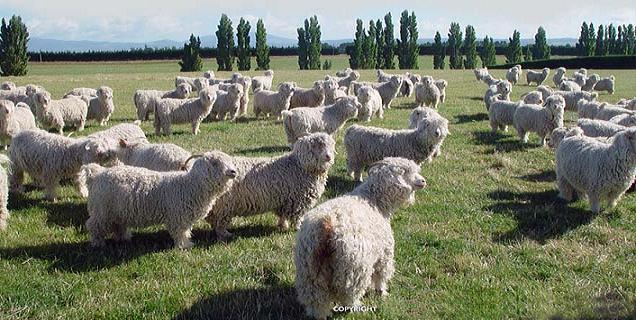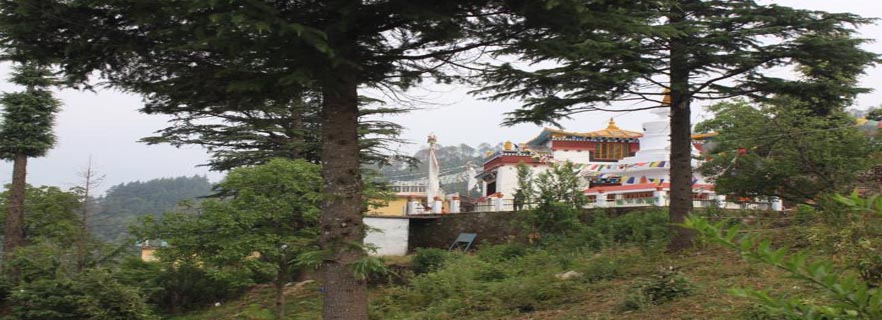
As the road begins to snake up to the Pindar River Basin from Tharali, the lush aroma of the woods begins to tickle your senses. Villages with identical white houses appear sporadically amid lush fields of wheat and bright red Amaranthus. As you stare at the distant northern horizon, your gaze falls on a dense forest of rhododendrons and oaks, and beyond them the spotless white faces of the mighty Trishul, Maiktoli and Nanda Ghunti peaks.
Before you know it, you’re at the top of the ridge and closing in on the tiny hamlet of Gwaldam. Mined to the hilt by the British as a summer resort, Gwaldam (6,221 ft) still holds remnants of the Raj in well-preserved nooks of this idyllic, quiet corner of Chamoli. Why it should have been paid so little attention in all the modern-day tourism hype is mystifying, but it’s probably just as well. I, for one, seem to have found a place that seems to have fallen off the well-trod path.
If you were heading to Bedni and Ali bugyals, the famous high-altitude pastures of Chamoli , you would pass through Gwaldam. And most people do just that – use it as a base for treks. But to give Gwaldam a miss is to lose an opportunity to experience a uniquely composite hill culture, existing as it does on the border between Garhwal and Kumaon. There are Garhwalis, Kumaonis, even a small settlement of Bhotias here. There is none of the traditional rivalry between the two neighbours, its residents speak a dialect that is neither Kumaoni nor Garhwali but a mix of both. All of which makes Gwaldam a place like no other in Uttarakhand.
THINGS TO SEE AND DO
The border town of Gwaldam peers into Kumaon to its south and faces the panoramic
march of the mighty Himalaya to the north. It is spread over 6 sq km, straddling
a deeply forested hill. The Bhagwati (Nanda Devi) Temple lies at the crossroads
of the town, around which the few hotels and the small market area thrive. The
Seema Suraksha Bal (Border Security Force) training facility stretches over a
vast area in the upper part of town. This gives the town a cantonment feel, while
still pretty remnants of the Raj, such as the fishery and the Forest Rest House,
evoke nostalgia for a bygone era.

Walks out of Benatoli Gwaldam will tempt the most unbending couch potato to stretch her feet. There are three excellent, not too challenging walks to be had, to Agyari Mahadev, Badhangarhi Fort and Gwaldam Nag Temple. All these walking trails begin at Benatoli. To get there, drive back down the road towards Tharali, and 3 km out of Gwaldam, you will see a road going left. This is the Benatoli Campus Road, which ends at Benatoli. As you drive in you will see the Bhim Patthar rock. Legend goes that the Pandava brother Bhim kicked a rock at Badhangarhi, which fell at this spot with his footprints imprinted on it. From here, a 1-hr/ 2-km trail uphill through a lush forest of pine and rhododendron leads to the ridge-top Badhangarhi (7,415 ft). Equally revered by both Kumaonis and Garhwalis, the Kali shrine here is full of bells strung by devotees. Of the 52 garhs of petty chieftains in Garhwal, this, the last stronghold, had faced many attacks from Kumaon. Remnants of old fort walls can be seen above the temple. A 5-min climb from the temple takes you to a vantage point that offers a panoramic view of the mountains to the north, Trishul and the great ridges of Chaukhamba, to the south, the vast bowl of Kumaon’s lush Katyuri Valley.
Two paths lead from Benatoli up to Agyari Mahadev. The right fork is a 4-km foray into the ridge-top forest to this ancient Shiva shrine. The left fork affords gentler access. The former route comes alive with local fervour during Maha Shivaratri in February-March.
Another 2-hr trail from Benatoli due south-east takes you to the hilltop shrine of Gwaldam Nag, which gives the town its name. This temple, dedicated to the serpent god, looks down into the valley pand and up towards the Himalaya. Bodh Mandir, Baghtoli At Baghtoli (1 km from the Gwaldam Bus Stand), a short 5-min walk from the road leads to a Bhotia settlement of 15 families who settled here in the late 1950s. The gompa here, popularly known as Bodh Mandir, was built in 1989. You’ll spot its bright yellow roof from a distance. The sanctum is lined with statues of various incarnations of the Buddha. A narrow staircase leads to the rooftop of the monastery from where, through strings of colourful prayer flags, you can see the vast expanse of the valley below.
Angora Farm
The state-run Angora Farm is a kilometre ahead of Gwaldam’s main bazaar. Established in 1987, the farm has five shilas or homes for 170 mohair goats. Each shila houses 35 animals. During the day, the goats are taken to graze in the nearby meadows, leaving the newborns safely behind. One enclosure has 60 massive German angora rabbits. The man in charge, BS Dungrial, runs a tight shift but will happily give you the lowdown on the elaborate breeding and feeding habits of these exotic rabbits.
Machhi Tal
Hidden in a nook in the ridge along a gentle stream 9 km out of Gwaldam on the road to Debal, Machhi Tal came up in 1928, when the British thought they would breed fish here for personal consumption. Now run as a fish production farm by the state government, this tranquil spot amidst thick forests makes for a lovely picnic spot.

More to do
It’s an easy 45-min walk from the bus stand to the grazing pasture of Dhan Kharak. Jaideep Top, named after a locally famous journalist, offers splendid views of the Katyuri Valley and the Himalaya. Subhash Bhadiyari’s Nursery, 200m ahead of the Angora Farm, is an education in the art of growing vegetables. Besides producing his own geranium oil, Bhadiyari grows a wide variety of flowers, herbs and vegetables.


Thanks with regard to providing this kind of wonderful post.